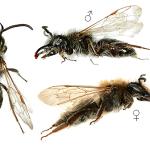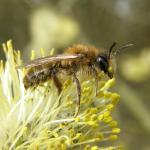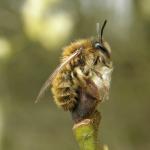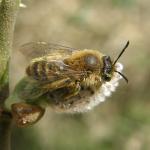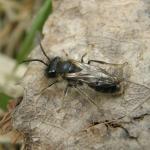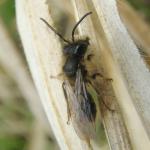Andrena smithella KIRBY 1802; Andrena clypeata SMITH 1855;
Andrena praecox and A. apicata comprise a closely related species-pair, individuals of which can be difficult to identify (especially with respect to females). In some sites, both species fly together.
Rather local, but often common where it does occur, throughout much of southern Britain, as far north as south Yorkshire. Perkins (1919) records the species from Scotland, though no locality is listed. There are no records of it from the Channel Islands. In Ireland, reported from Wexford, Kilkenny, Carlow, Wicklow and Dublin (Stelfox 1927). In Europe, the species is broadly boreo-alpine, ranging from Fennoscandia and Germany south to Spain, Austria and northern Italy. In Asia, found in the Caucasus.
This species is not regarded as being scarce or threatened.
Heathland and open woodland where there is sufficient sallow to support populations of this bee.
Univoltine; early March to the end of April or early May.
Small nesting aggregations have been encountered in sparsely vegetated deciduous woodland (M Edwards, pers. comm.; G R Else, pers.obs.). Perkins (1919) mentions large nesting aggregations, though on mainland Europe the species is reported to nest solitarily (Dylewska 1987; Westrich 1987).
Females have only been seen visiting sallow (Salix spp.)catkins. Although males often fly about these blossoms, they rarely seem to visit the flowers for nectar.
The rare cleptoparasitc bee Nomada ferruginata attacks the nests of this species (Perkins 1919; Westrich 1989). Specimens are rarely stylopized.
2002


